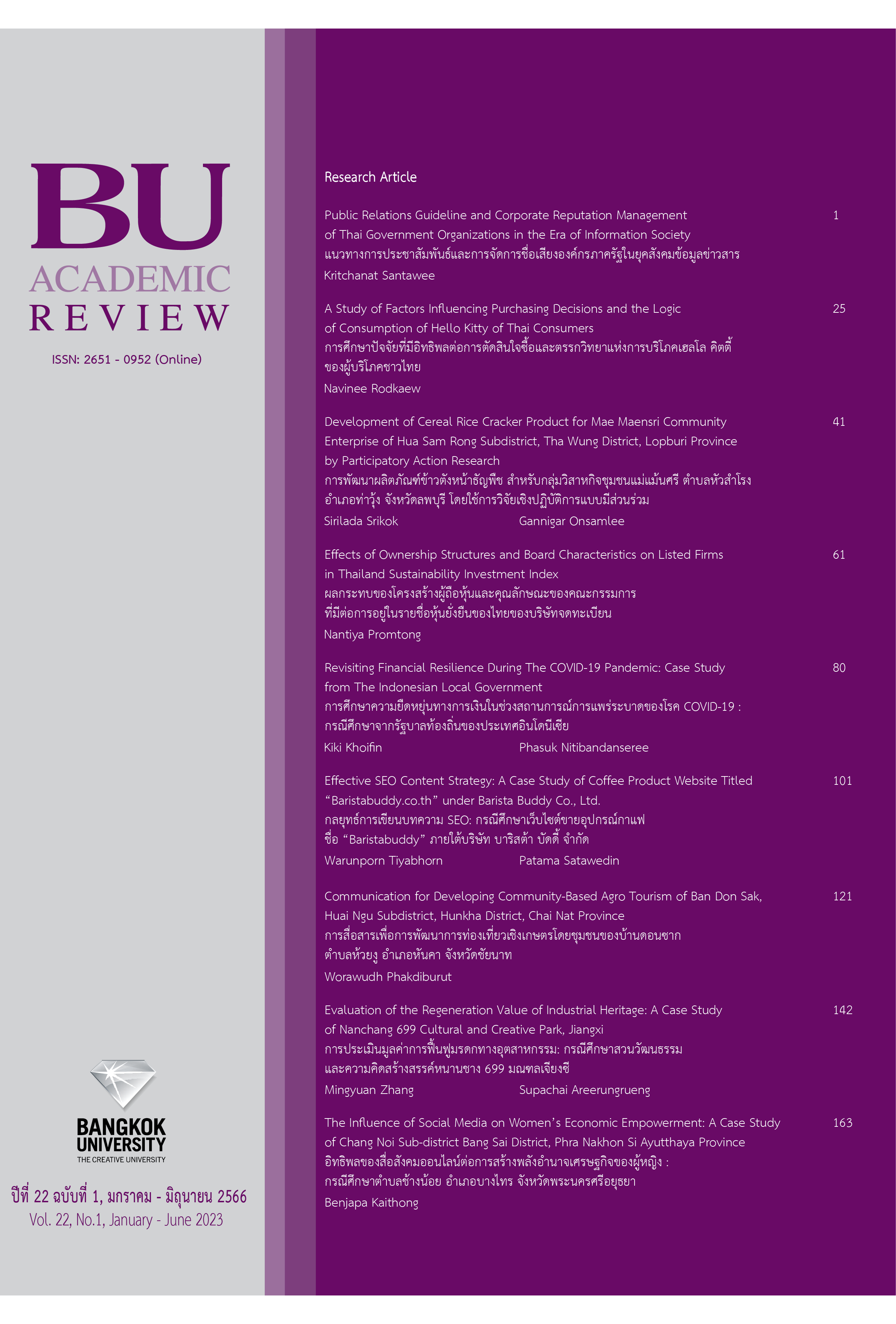Public Relations Guideline and Corporate Reputation Management of Thai Government Organizations in the Era of Information Society
Main Article Content
Abstract
This research aimed to 1) study public relations guidelines of Thai government organizations, 2) study corporate reputation management of Thai government organizations, and 3) study corporate reputation factors of Thai government organizations. The data were collected from 300 government organization employees and 400 citizens using a questionnaire and then analyzed with descriptive statistics, sum, percentage, arithmetic mean, standard deviation, and second order confirmatory factor analysis with the LISREL program, combined with an in-depth interview with government organization officers about public relations guidelines and corporate reputation management of Thai government organizations.
The findings indicated a concordant cause-effect relationship in corporate reputation of Thai government organizations based on an adjusted model, with Chi-Square (χ2) of 1041.62, df of 930, p-value of 0.00, RMSEA of 0.02, RMR of 0.19, SRMR of 0.04, GFI of 0.93, and CFI of 1.00. Every element of corporate reputation management had influence on reputation capital at a rate of 60.00 percent. The elements of issue and crisis management and the balanced two-way public relations had influence on corporate reputation the most, at a rate of 66.00 percent. Corporate reputation had influence on reputation capital in the aspect of the benefits of operating strategiesthe most, at a rate of 94.00 percent.
Article Details

This work is licensed under a Creative Commons Attribution-NonCommercial-NoDerivatives 4.0 International License.
The manuscript submitted for publication must be the original version, submitted only to this particular journal with no prior acceptance for publication elsewhere in other academic journals. The manuscript must also not violate the copyright issue by means of plagiarism.
References
Al, R., Lynch, R., Melewar, T. C., & Jin, Z. (2015). The moderating influences on the relationship of corporate reputation with its antecedents and consequences: A meta-analytic review. Journal of Business Research, 68(2015), 1105–1117.
Agarwal, J., Osiyevskyy, O., & Feldman, P. M. (2015). Corporate reputation measurement: Alternativefactor structures, nomological validity, and organizational outcomes. Journal
Business Ethics, 130(2), 485-506.
Almeida, M. G. M. C., & Coelho, A. F. M. (2019). The antecedents of corporate reputation and
image and their impacts on employee commitment and performance: The moderating
role of CSR. Corporate Reputation Review, 22(2), 10-25. doi: 10.1057/s41299-018-0053-8
Barnett, M. L., Jermier, J. M., & Lafferty, B. A. (2006). Corporate reputation: The definitional landscape. USA: University of South Florida Press.
Caruana, A., Ramaseshan, B., & Ewing, M. T. (2001). Anomia and deviant behaviour in marketing:
some preliminary evidence. Journal of Managerial Psychology, 16(5), 322–338. https://doi.org/10.1108/EUM0000000005526
Changchutoe, N. (2011). Public relations strategy on social network. Executive Journal, 31(2),
-183.
Davies, G., Chun, R., de Silva, R. V., & Roper, S. (2001). A corporate character scale to assess
employee and customer views of organization reputation. Corporate Reputation Review,
(2), 125-146.
de Quevedo-Puente, E., de la Fuente-Sabaté, J., & Delgado-García, J. (2007). Corporate social performance and corporate reputation: Two interwoven perspectives. Corporate Reputation
Review, 10(1), 60-72.
Dowling, R. (1994). Corporate reputation. Melbourne: Longman Professional Publishing.
Feldman, M. P., Bahamonde, A. R., & Bellido, V. I., (2014). A new approach for measuring corporate reputation. São Paulo, 54(1), 53-66.
Fombrun, C. J. (1996). Reputation: Realizing value from the corporate image. Massachusetts, USA:
Harvard Business Review Press.
Fombrun, C. J., & Van Riel, C. B. M. (1997). The reputational landscape. Corporate Reputation
Review, 1(1), 5-13.
Gotsi, M., & Wilson, A. M. (2001). Corporate reputation: Seeking a definition. Corporate
Communications: An International Journal, 6(1), 24-30. https://doi.org/10.1108/13563280110381189
Goztas, A., Koker, N. E., & Alemdar, M. Y. (2006). How to manage reputation during crisis: An
analysis of Turkish white meat sector during the avian influenza (ird Flu) crisis. Journal of
Yasar University, 3(12), 1761-1786.
Grunig, J. E., & Hunt, T. (1984). Managing public relations. Fort Worth, TX: Harcourt Brace Jovanovich College Publishers.
Hooper, D., Coughlan, J., & Mullen, M. (2008). Structural equation modelling: Guidelines for
determining model fit. Electronic Journal of Business Research Methods, 6(1), 53-60.
Lertphisunh, J., Srisattarat, S., Norrapattaveeporn, K., & Sanartit, P. (2017). Reporting public relations
in the next decade (2011-2020). Siam Communication Review, 10(11), 186-206.
Lapiratanakul, W. (2006). Public relations (11th ed.). Bangkok: Chulalongkorn University Press.
Lewellyn, P. G. (2002). Corporate reputation: Focusing the zeitgeist. Business and Society, 41(4),
-455.
Mahasinpaisan, T. (2012). The project management of public relations in government and non-
profitorganizations. The Report of Bangkok University Academic Conference 2012 (pp.61-
. PathumThani: Bangkok University Press.
Mahon, J. F. (2002). Corporate reputation: Research agenda using strategy and stakeholder
literature. Business & Society, 41(4), 415 – 445.
Pires, V., & Trez, G. (2017). Corporate reputation: A discussion on construct definition and measurement and its relation to performance. Revista de Gestão, 25(1), 47-64.
Pitipattanakosit, U. (2000). The evolution of public relations in Thailand. KhonKaen:
University of Northeastern.
Puente, S., Crous, F., & Bosch, A. (2007). The role of a positive trigger event in actioning authentic
leadership development. SA Journal of Human Resource Management, 5(1), 11-18.
Roberts, P. T., & Dowling, G. R. (2002). Corporate reputation and sustained superior financial
performance. Strategic Management Journal, 23, 1077-1093. doi.org/10.1002/smj.274
Rose, C., & Thomsen, S. (2004). The impact of corporate citizenship: Social investing, reputation.
Management Journal, 22(2), 201-210.
Santawee, K., & Pritpreecha, R. (2013). The factors influencing corporate reputation and corporate reputation management in Thailand. Journal of Communication Arts, 31(4), 1-12.
Šmaižien, I., & Oržekauskas, P. (2006). Corporate image audit. Vadyba/ Management, 1(10), 89–
Sontaite-Petkeviciene, M. (2014). Crisis management to avoid damage for corporate reputation: The case of retail chain crisis in the Baltic countries. Procedia - Social and Behavioral Sciences, 156(2014), 452-457.
Yamane, T. (1970). Statistic: An introductory analysis (2nd ed.). New York: Harper & Row.
Wartick, S. L. (2002). Measuring corporate reputation definition and data. Business & Society,
(4), 371-392.
Wei, Y. (2002). Corporatization and privatization: A Chinese perspective. Northwestern Journal of
International Law & Business, 22(2), 219-234.
Whetten, D. A., & Mackey, A. (2002). A social actor conception of organizational identity and its implication for the study of organizational reputation. Business & Society, 41(4), 393-414.

